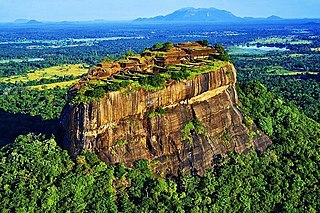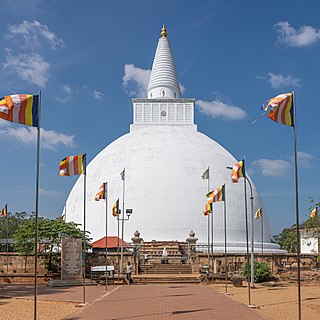
Anuradhapura is a major city located in the north central plain of Sri Lanka. It is the capital city of North Central Province and the capital of Anuradhapura District. The city lies 205 kilometers (127 mi) north of the current capital of Colombo in the North Central Province, on the banks of the historic Malwathu Oya. The city is now a World Heritage Site famous for its well-preserved ruins of the ancient Sinhalese civilisation.

Sigiriya or Sinhagiri is an ancient rock fortress located in the northern Matale District near the town of Dambulla in the Central Province, Sri Lanka. It is a site of historical and archaeological significance that is dominated by a massive column of granite approximately 180 m (590 ft) high.

Tissa, later Devanampiya Tissa, meaning, was one of the earliest kings of Sri Lanka based at the ancient capital of Anuradhapura. According to the traditional chronology, he ruled from 307 BC to 267 BC, but the modified chronology adopted by modern scholars such as Wilhelm Geiger assigns his reign to 247 BC to 207 BC. His reign was notable for the arrival of Buddhism in Sri Lanka under the aegis of the Mauryan Emperor Ashoka the Great. The primary source for his reign is the Mahavamsa, which in turn is based on the more ancient Dipavamsa.

Kuttam Pokuna are well preserved old bathing tanks or ponds in Sri Lanka. This pair of ponds was built by the Sinhalese in the ancient Anuradhapura Kingdom. They form part of the Abhayagiri vihāra complex and are an example of the works in the field of hydrological engineering, architecture and art of the ancient Sinhalese.

The Mirisaweti Stupa is a memorial building, a stupa, situated in the ancient city of Anuradhapura, Sri Lanka. King Dutugamunu built the Mirisaveti Stupa after defeating King Elara. After placing the Buddha's relics in the sceptre, he had gone to Tissa Wewa for a bath leaving the sceptre. After the bath, he returned to the place where the sceptre was placed, and it is said that it could not be moved. The stupa was built in the place where the sceptre stood. It is also said that he remembered that he partook in a chilly curry without offering it to the Sangha. In order to punish himself he built the Mirisavetiya Dagaba. The extent of this land is about 50 acres. Although the king Kasyapa I and Kasyapa V renovated this, from time to time it was dilapidated.

Dakkhina Stupa is a 2nd-century BC large brick Stupa in Anuradhapura, Sri Lanka. Earlier thought to be a monument of King Elara, it was later identified as the Stupa of ancient Dakini (Dakkhina) Vihara by Senarath Paranavithana with the help of a Brahmi inscription of the 3rd century A.D. unearthed from the ground between the southern and western Vahalkadas of the Stupa.
Solosmasthana are 16 sacred places in Sri Lanka, believed by Buddhists to have been hallowed by visits of Gautama Buddha. These places of worship are among the most important religious locations in Sri Lanka, and are located throughout the country. Ancient Buddhist and historical sources of Sri Lanka assert that the Buddha visited the country on three occasions. These three visits are given in some detail in the ancient chronicle Mahavamsa, which describes his journeys to eleven of the Solosmasthana. Other sources such as the Pujavaliya, Samantapasadika and Butsarana also mention these visits. But there are no reliable source proves this matter. Professor senarath paranavithana in his day announced that he was not able to say that Buddha visited Sri Lanka, due to lack of archaeological evidence.

The Polonnaruwa Vatadage is an ancient structure dating back to the Kingdom of Polonnaruwa of Sri Lanka. It is believed to have been built during the reign of Parakramabahu I to hold the Relic of the tooth of the Buddha or during the reign of Nissanka Malla of Polonnaruwa to hold the alms bowl used by the Buddha. Both these venerated relics would have given the structure a great significance and importance at the time. Located within the ancient city of Polonnaruwa, it is the best preserved example of a vatadage in the country, and has been described as the "ultimate development" of this type of architecture. Abandoned for several centuries, excavation work at the Polonnaruwa Vatadage began in 1903.

A kachcheri or district secretariat is the principal government department that administrates a district in Sri Lanka. Each of the 25 districts has a kachcheri.
Rajagala, commonly Rassaagala or Rajagalathenna, is a rugged and heavily forested mountain situated 1,038 feet (316 m) above sea level, in a sparsely populated part of Eastern Province, Sri Lanka which has an important archaeological value. The Rajagala archaeological site is only second to the Mihintale monastery in Anuradhapura and it spreads over 1,600 acres. It consists more than 600 prehistoric ruins, monuments and artifacts, and nearly 100 of them are ancient stupas.

The Sinhalese monarchy has its origins in the settlement of North Indian Indo-Aryan immigrants to the island of Sri Lanka. The Landing of Vijay as described in the traditional chronicles of the island, the Dipavamsa, Mahavamsa and Culavamsa, and later chronicles, recount the date of the establishment of the first Sinhala Kingdom in 543 BC when Prince Vijaya, an Indian Prince, and 700 of his followers are claimed to have landed on the island of Sri Lanka and established the Kingdom of Tambapanni. In Sinhalese mythology, Prince Vijaya and followers are told to be the progenitors of the Sinhalese people. However according to the story in the Divyavadana, the immigrants were probably not led by a scion of a royal house in India, as told in the romantic legend, but rather may have been groups of adventurous and pioneering merchants exploring new lands.
Mihintale Archaeological Museum is an archaeological museum in Mihinthale, Anuradhapura district, North Central province, Sri Lanka.

The Department of Archaeology is a non-ministerial government department in Sri Lanka responsible for managing the archaeological heritage.
Doctor Charles Edmund Godakumbura was the Commissioner of Archaeology in Ceylon from 1956 to 1967.

Maligatenna Raja Maha Vihara is an ancient Cave temple located in Malwatuhiripitiya village, Gampaha District, Sri Lanka. The temple is located on the Gampaha-Wathurugama Road and approximately 1.6 km (0.99 mi) away from the ancient temple Pilikuththuwa Raja Maha Vihara.

Warana Raja Maha Vihara is an ancient Buddhist temple situated in Thihariya, Gampaha District, Sri Lanka. The temple is located approximately 5 km (3.1 mi) away from the Colombo - Kandy highway. Currently this temple has been recognized as an archaeological protected site in Gampaha District by Archaeological department.

Panduwasnuwara Archaeological Museum is an archaeological Museum in Panduwasnuwara, Sri Lanka. It is located at Kotampitiya junction on Kurunegala-Chilaw road, near to the ancient shrine Panduwasnuwara Raja Maha Vihara. The museum serve as the regional museum for North Western Province of the country and is maintained by Archaeological department of Sri Lanka.
Girihandu Seya is an ancient Buddhist temple situated in Thiriyai, Trincomalee, Sri Lanka. The temple is supposed to be the first Buddhist Stupa in Sri Lanka, believed to be constructed by two seafaring merchants Trapusa and Bahalika. The names of the two merchants are recorded in a rock inscription found in the Vihara premises. According to the inscription, Girihandu Seya was built by the guilds of merchants named Trapassuka and Vallika where the names are written as Tapassu and Bhalluka in later Sinhala chronicles. Some scholars also hold the view that Mahayana influenced seafaring merchants from the Pallava Kingdom were responsible for the construction of this temple.
Senake Dias Bandaranayake was a Sri Lankan archeologist, who served as emeritus professor and vice chancellor at University of Kelaniya. His research was focused on architecture, art history, and ancient paintings of South Asia, including Sri Lanka.
Sandahiru Seya is a second largest hemispherical stupa in Sri Lanka located in Anuradhapura.














